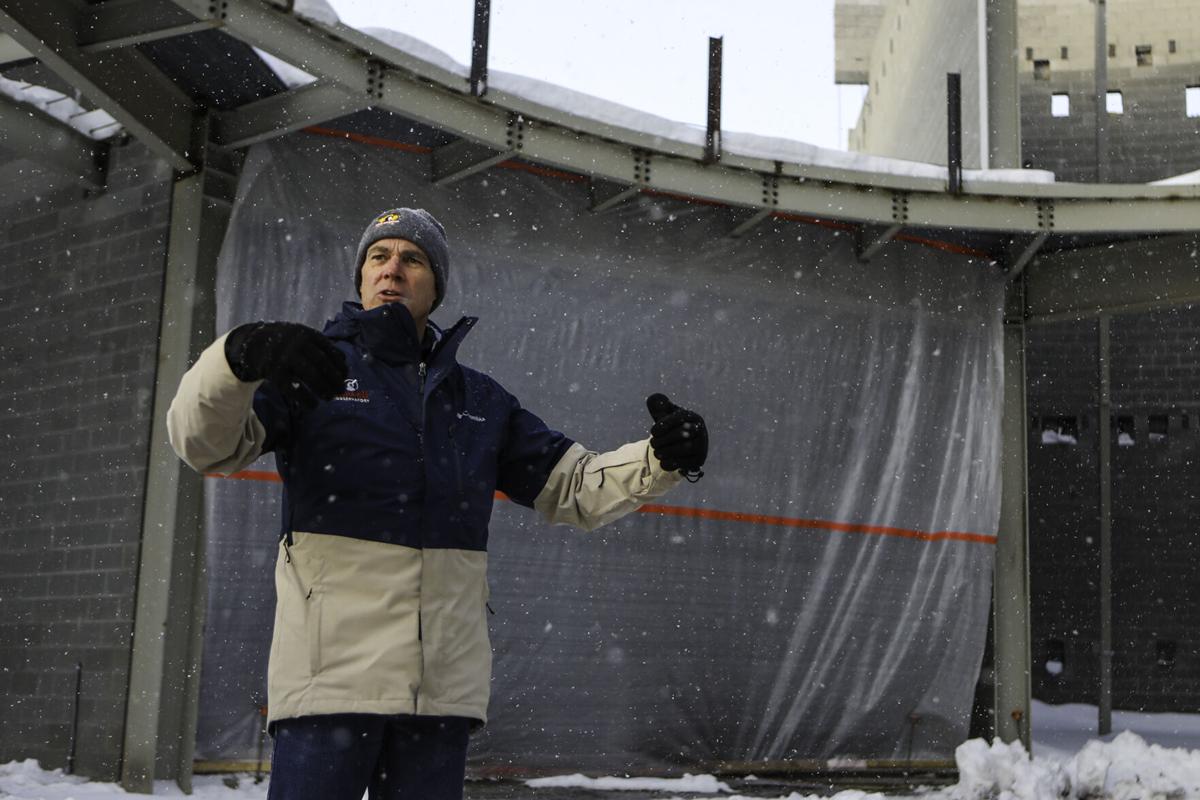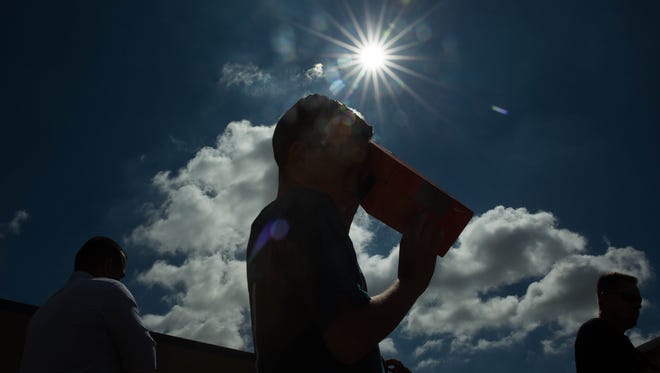Lowell Observatory has been making progress on constructing its new Kemper and Ethel Marley Foundation Astronomy Discovery Center (ADC), despite pandemic-related increases in cost.
Construction continues on Lowell Observatory’s new Astronomy … – Arizona Daily Sun

Technical Project Manager Dave Sawyer discusses the work being done on the new Astronomy Discovery Center at Lowell Observatory Monday afternoon. When complete, some of the features the 40,000-square-foot building will include a 30-foot-tall, 160-degree view Universe Theater, a open-roof dark sky planetarium with heated seating, a curiosity zone for children aged 0-8, an astronomy gallery and a cosmic classroom.
Rachel Gibbons, Arizona Daily Sun
The 40,200-square-foot ADC building is set to open in the fall of 2024 and has raised $39.8 million of the $53.6 million total costs.
The ADC is part of the observatory’s “next generation of outreach” on its way to becoming the “premier astronomy education destination in the world,” according to director Jeff Hall.
He said the center is meant to get visitors to start “wondering about what’s out there and creating experiences of awe and curiosity, opening minds to the wonders of the universe. Hopefully that sends people off Mars Hill with a new perspective on the world and a renewed interest in questioning the things around them.”
People are also reading…
- ‘Where do we go?’ Winter parking restrictions near public land confound Flagstaff locals
- More snow in the forecast for Flagstaff on Monday and Tuesday
- East Flagstaff Safeway evacuates following roof collapse
- Flagstaff’s separated bike lanes remain a ‘learning process’ in their second winter
- Coconino County takes first steps toward regulating short-term rentals
- Mount Elden Middle School placed on lockdown following knife attack
- Flagstaff police investigate possible exposure death
- Measuring homelessness in Flagstaff: Point in Time study determines where people sought shelter on one January night
- “The most dangerous thing”: Flagstaff fire crews put out flames on the interstate
- Earth’s inner core may have stopped turning and could go into reverse, study suggests
- NAU roots to NFL success: Two former Lumberjacks to coach in AFC championship game
- Trial underway for Flagstaff man accused of molesting 4 girls
- Working in a winter wonderland: assessing the economic impact of January’s winter storms in Flagstaff
- Reunion to celebrate 50th anniversary of Coconino High School title team
- Winter welfare: Checking in on Flagstaff animals in snowy conditions
Chief marketing and revenue officer Danielle Adams explained that the new building will be more of a science discovery center than a visitor’s center, meaning it is part of the attraction rather than just its introduction.

A large opening in Lowell Observatory’s Astronomy Discover Center, which began construction in fall of 2022, is all steel beams and cinder blocks Monday afternoon. When complete, this space will feature a large sculpture depicting an artist’s rendition of the Big Bang.
Rachel Gibbons, Arizona Daily Sun
This purpose can be seen in some of the main features, the outlines of which are already visible in the cinder blocks and steel beams of construction completed so far.
The project, which broke ground in June 2021, is currently around 40% complete.
An open dark sky planetarium will top the three-story building, using Flagstaff’s night sky for a display rather than a traditional enclosed dome. Educational programs will use a screen coming up from the wall and laser pointers to identify features in the sky, while heated seats will allow for year-round use.
A universe theater with an immersive 160-degree wraparound screen will be on the ground floor. The two-story-tall screen will use LED images rather than projection to recreate the “dark rich blacks” of space.
“We’re going to put you on the surface of Mars or Pluto or zooming through clusters of galaxies as they cannibalize each other,” Adams said. “ … All of those visuals are intended to supplement the live educator presentations. It’s not just about going into a cool theater and watching a movie. It’s really to supplement the story that we’re telling.”
Both the planetarium and the theater will have 180 seats; the largest space in the current visitor’s center seats 100.
The lower floor will also feature a curiosity zone designed for children 8 and younger with interactive exhibits. A second gallery for those aged 9 and older will also feature scientific discoveries at Lowell.

Construction on Lowell Observatory’s new Astronomy Discovery Center is about 40% complete Monday afternoon. When complete, some of the features the 40,000-square-foot building will include a 30-foot-tall, 160-degree view Universe Theater, a open-roof dark sky planetarium with heated seating, a curiosity zone for children aged 0-8, an astronomy gallery and a cosmic classroom.
Rachel Gibbons, Arizona Daily Sun
The entire space has been designed with accessibility and inclusivity in mind, Adams said, describing it as ADA+.
Some examples are a nursing room, sound-isolating domes in the ceiling and the use of Exhibit Designs for Girls’ Engagement (EDGE) principles from the Exploratorium in San Fransisco — design attributes meant to engage girls in STEM exhibits.
The ADC is meant as an expansion to Lowell’s offerings, so objects such as the Clark Refractor and Pluto Discovery Telescope will still be there even after its completion. Other aspects of the existing visitor’s center (the gift shop, for example), will be moved to an upgraded space in the new center. Once the ADC is finished, the current Steele Visitor’s Center will be used as a learning location for educational programs, camps and scientific conferences among others.
About a year and a half into construction, the observatory plans to have an enclosed weatherproof building finished this fall. After that it will be completing fittings and finishings next spring in time for a fall opening next year.
Big economic bang
Plans for expansion at Lowell began around 2016 with the Giovale Open Deck Observatory first conceptualized in June 2017 and opening in fall 2019. Hall described that project — which cost $4.4 million — as an “appetizer” to the ADC’s main course.
Around the same time, it began planning for the astronomy center, announcing the project in June 2019 and breaking ground on June 26, 2021.
Before the pandemic, Hall said, Lowell had more than 100,000 visitors each year — an amount neither the existing visitor center nor parking options were able to accommodate. The expansion is meant to allow Lowell Observatory to serve those visitors (adding 204 parking spots, for example) and expand Flagstaff’s astrotourism offerings.
With Flagstaff’s status as the first dark sky city, northern Arizona’s history of astronaut training, Lowell’s part in the discovery of Pluto and nearby landmarks such as Meteor Crater, the city already has a lot of connections to astrotourism. One of Lowell Observatory’s largest economic impacts comes from the overnight visitors it brings to Flagstaff who will often come in the evening to stargaze and then spend the night in the city.
Adams cited a 2016 survey that found that 80% of those living in the United States aren’t able to see the Milky Way from their homes.

Construction on Lowell Observatory’s new Astronomy Discovery Center is about 40% complete Monday afternoon.
Rachel Gibbons, Arizona Daily Sun
“We see the Milky Way from downtown Flagstaff. People are coming here, they want to experience the stars themselves, but then we also have this amazing history and physical spaces,” she said.
She added: “There are a lot of things that can draw people to Flagstaff for astrotourism, and the ADC is one of those things that will be an even bigger piece.”
A 2017 study by Discover Flagstaff found that every overnight guest brings an economic impact of $299 to the Flagstaff, meaning that the 250,000 tourists the ADC is expected to bring to northern Arizona every year will bring an estimated $74.5 million to the local economy.
It also expects to create 420 jobs in constructing and running the ADC, paying $12.5 million in employee salaries each year.
While the project’s timing meant that the pandemic didn’t have much of an effect on the timeline, in recent years related supply chain costs have added to its cost.
The ADC was still in the planning phase when the virus first arrived, meaning that the only construction work needing to be done early in the pandemic was clearing the site — work that could be done safely outdoors. The rest was planning meetings, which took place remotely.
The initial budget — $39.5 million — had been successfully raised, funded entirely by donations. When final bids came in from contractors in August, however, the cost had risen by 36%, forcing the observatory to need to raise another $14 million to be able to complete the project. The total budget is now $53.6 million.
A lot of these extra costs are mundane, but necessary, items, said Chief Philanthropy Officer Lisa Actor — concrete or plumbing and electrical equipment — that have risen in price due to supply chain issues. It is continuing to use already raised funds while the observatory is “pull[ing] out all the stops” to find the rest.
LD7 Rep. David Cook has introduced HB 2287 to the Arizona House, asking for $14 million from the state general fund to support the project. Actor acknowledged that there are several other projects requesting funding from the state, so she remains hopeful while looking for other options.
The observatory’s leaders said their hope is that the center will inspire and educate people of all ages.
“Progression from having an experience of awe and wonder which generates curiosity and questioning and investigating for yourself what is going on here, and then getting to this place of better understanding,” Adams said.
Adams added: “That whole cycle starts with encountering something that’s bigger than yourself; there’s a phrase used, discrepant events, where what you see isn’t what you thought you would see. Those things run a bit counter to what we have in our heads, and it causes us to open our minds a little bit … [In] today’s world, people can be so entrenched in their positions and know they’re 100% right and 0% wrong, and if through this we can get people to learn something about the universe but also experience for themselves and open up their minds, then we’ve done our job “
“We can’t solve all the world’s problems from Mars Hill,” Hall said, “but we can do our little bit to inspire the people that come up here.”
More about the new ADC can be found at lowell.edu/adc.
Correction:
An earlier version of this article omitted Lisa Actor’s job title of Chief Philanthropy Officer and misidentified Technical Project Manager Dave Sawyer as Astronomer Dave Schleicher in a photo caption. It has been updated to include this informatiion.










